 |
 |
 |
|

 MAY 2009
MAY 2009 |
 |
Drought Tolerant Seasonal Color Plant Choices
Is your area of the country experiencing drought conditions? Do you have outdoor watering restrictions? Although these present a real challenge to landscapes, there are several seasonal color plant varieties that will survive periods of limited rainfall or irrigation. The following plant types can still provide a brilliant color display while requiring much less irrigation or rainfall.
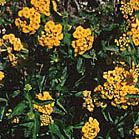 LANTANA – Available in many varieties and colors including ‘New Gold’ bright yellow, ‘Sunset’ orange/yellow, ‘Confetti’ and Trailing Lavender or White. New Gold™ Lantana LANTANA – Available in many varieties and colors including ‘New Gold’ bright yellow, ‘Sunset’ orange/yellow, ‘Confetti’ and Trailing Lavender or White. New Gold™ Lantana
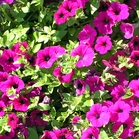 PETUNIA – Especially the ‘Wave’ series available in pink, purple, blue and lavender. Purple Wave Petunias (with thanks to Karen Russ, Clemson Ext., for the photo!) PETUNIA – Especially the ‘Wave’ series available in pink, purple, blue and lavender. Purple Wave Petunias (with thanks to Karen Russ, Clemson Ext., for the photo!)
VERBENA – Especially ‘Homestead Purple’ variety. Homestead Verbena
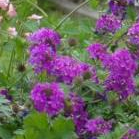
SWEET POTATO VINE Chartreuse Sweet Potato Vine

DRACAENA – Use as an accent plant. Variegated Dracaena

VINCA
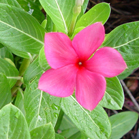
MEXICAN PETUNIA
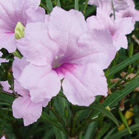

Need
help? Have questions?
Contact your OLM representative with questions or comments concerning the information in The Grapevine. As always, we welcome your feedback! Contact OLM by phone, e-mail or fax and we will
be glad to assist! |
Memorial Day
May 25, 2009

|
 |

|
 |
| |
|
I have no plants in my house. They won't live for me. Some of them don't even wait to die, they commit suicide. ~Jerry Seinfeld
A Green Way to Fight Pink?
 USDA’s Agricultural Research Service (ARS) has developed a new pheromone to help control the pink hibiscus mealybug, a pest that causes up to $750 million in damage annually to U.S. crops. The ARS has granted an exclusive license to South Carolina Scientific Inc. of Columbia, SC, to produce and market the insect sex pheromone. USDA’s Agricultural Research Service (ARS) has developed a new pheromone to help control the pink hibiscus mealybug, a pest that causes up to $750 million in damage annually to U.S. crops. The ARS has granted an exclusive license to South Carolina Scientific Inc. of Columbia, SC, to produce and market the insect sex pheromone.
The pink hibiscus mealybug (Maconellicoccus hirsutus) causes severe economic problems  worldwide by attacking a wide range of plants, including many species of ornamentals. The pest is native to Asia but appeared on U.S. soil in 1984 in Hawaii via imported cargo. It was found in California in 1999 and reached Florida in 2002. worldwide by attacking a wide range of plants, including many species of ornamentals. The pest is native to Asia but appeared on U.S. soil in 1984 in Hawaii via imported cargo. It was found in California in 1999 and reached Florida in 2002.
The pheromone, placed inside sticky traps, effectively monitors and traps mealybug males in the field by drawing them into the traps. Work is now under way to improve the process for chemically producing the pheromone. By luring males to traps, the pheromone would provide a much more economical, convenient, and useful detection and monitoring tool. There's also a second potential control strategy. It was found that relatively high concentrations of the pheromone repel males away from the source. In this scenario, the pheromone could control the pest by disrupting mating.
Another advantage of the pheromone is that natural enemies, or biological controls, of the pest aren't lured to the pheromone source. This allows scientists to chart the effectiveness of the biological controls used to combat the mealybug without artificially concentrating these natural enemies near the traps. |
There “Mite” Be A Cure
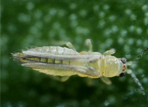
The Tampa Bay Business Journal reports, "University of Florida research shows a predatory mite consumes chilli thrips, an invasive crop pest.
The predatory mite, known scientifically as Amblyseius swirskii, is available commercially to manage whiteflies and broad mites. The mite could provide a much-needed alternative to pesticides for greenhouse crops, including bell peppers, strawberries and basil, Lance Osborne, professor at UF’s Institute of Food and Agricultural Sciences, said in a statement. Thrips attack more than 100 host plants including citrus, tomatoes, strawberries and bell peppers, a release said. Thrips spread from Asia to Florida in 2005.
 The U.S. Department of Agriculture estimates chilli thrips could cause losses of $4 billion a year if they become more widely established. Additional research is planned to determine a way to use the predatory mites to protect roses. The U.S. Department of Agriculture estimates chilli thrips could cause losses of $4 billion a year if they become more widely established. Additional research is planned to determine a way to use the predatory mites to protect roses.
In Florida landscapes, Chili Thrips have proven to a troublesome pest on the commonly used Indian Hawthorn (Rhapiolepsis indica spp.). Research on implementation of beneficial organisms in commercial landscapes can reduce the need for expensive pesticide treatments potentially reducing the costs of landscape maintenance to clients.
Submitted by PG Woods
Photos Courtesy of IFAS |
|
|
| |
|
Congratulations Class of 2009!

|
|
|
 |
 |
 |
| |
|
|
 |
|
|
|
|